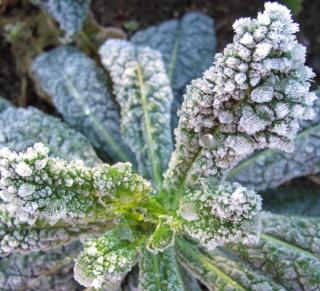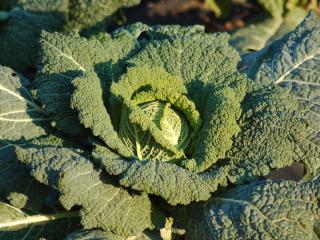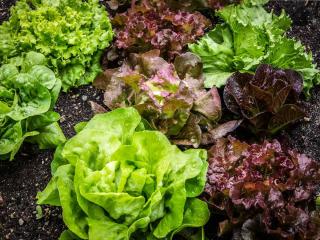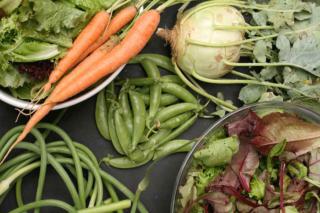

There are several different vegetables that are hardy enough to the cold that you can still make the vegetable patch an enchanting place to be. Zoom in on kohlrabi, Brussels sprouts, winter lettuce…
Your vegetable patch can actually be productive year-round, even after the sunny summer season has subsided… In fall, you can grow spinach, turnip, red beet, parsley, broccoli… And winter is when a variety of cabbage and lettuce steal away the show.
→ A greenhouse to grow more vulnerable veggies
 “A great many leaf vegetables can be grown in winter”, explains Linda Gray, the author of How to cultivate your garden in winter. “Brussels sprouts and lacinato kale, for instance, can be harvested even if you’ve got to shake a cover of snow off the plant. It still keeps growing even during the coldest of days! Sowing, however, takes place in spring, so that the seeds at least have an easy start in life with warmer soil…
“A great many leaf vegetables can be grown in winter”, explains Linda Gray, the author of How to cultivate your garden in winter. “Brussels sprouts and lacinato kale, for instance, can be harvested even if you’ve got to shake a cover of snow off the plant. It still keeps growing even during the coldest of days! Sowing, however, takes place in spring, so that the seeds at least have an easy start in life with warmer soil…
 Try other cabbage varieties out, sowing the seeds in plots as soon as summer harvests have been collected.” And Linda Gray shares more tips: “Kohlrabi or rutabaga is usually sown at the beginning of summer, it rests over the winter. Although it can be harvested even only two weeks after sprouting, it holds to the cold so well that you can leave it in the ground until the end of winter. […] Make the best of its hardiness and keep it planted right up to the day you plan to use it!”
Try other cabbage varieties out, sowing the seeds in plots as soon as summer harvests have been collected.” And Linda Gray shares more tips: “Kohlrabi or rutabaga is usually sown at the beginning of summer, it rests over the winter. Although it can be harvested even only two weeks after sprouting, it holds to the cold so well that you can leave it in the ground until the end of winter. […] Make the best of its hardiness and keep it planted right up to the day you plan to use it!”
→ Keep non-hardy root vegetables like early Egypt beet safe from freezing in a storage silo, even outside!
 Perhaps the easiest vegetable to plant and grow in winter is lettuce. “Not only are winter lettuce fun to grow, they also lend meals a feeling of summertime”, notes Linda Gray. “Chicory, arugula, lettuce, escarole, corn salad, watercress…
Perhaps the easiest vegetable to plant and grow in winter is lettuce. “Not only are winter lettuce fun to grow, they also lend meals a feeling of summertime”, notes Linda Gray. “Chicory, arugula, lettuce, escarole, corn salad, watercress…
Fall lettuce can be harvested until the first fall frost spells, whereas winter lettuce can hold until the following spring. A few Asian varieties can be planted at the end of summer for an autumn harvest […] and some varieties, like corn salad, will hold out during the entire year.”
 Source a few garden cloches to protect young plants from nightly frost especially, and expose the plants to fresh air during the day. Generally speaking, if this year winter is particularly harsh, do remember to prepare straw mulch to cover the base of your vegetables, as well as horticultural fleece to avoid really bad surprises. “Butterhead lettuce, in particular, is particularly well suited to harsh climates and only requires minimal protection.”
Source a few garden cloches to protect young plants from nightly frost especially, and expose the plants to fresh air during the day. Generally speaking, if this year winter is particularly harsh, do remember to prepare straw mulch to cover the base of your vegetables, as well as horticultural fleece to avoid really bad surprises. “Butterhead lettuce, in particular, is particularly well suited to harsh climates and only requires minimal protection.”
Care to try? “Sow from summer’s end to the last days of fall in a rather sheltered spot of the garden. Growing conditions depend on the cultivar and variety, so check the print on seed packets.”
When should you harvest them? When you find the lettuce heads large enough, except for leaf lettuce (like oakleaf) “that you can harvest a few leaves at a time every few days”.
Various bulbs are also planted in fall like white and violet garlic and onions (in mild climates). It’s even possible to sow these in January-February. They’ll slowly sprout roots in winter and burst forth in spring for a harvest within the season.
Claire Lelong-Lehoang